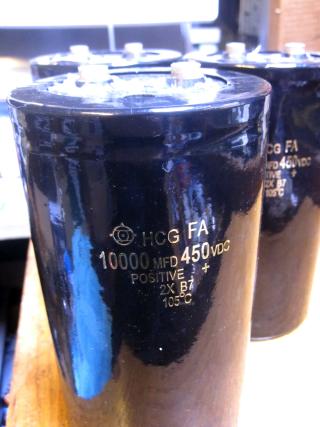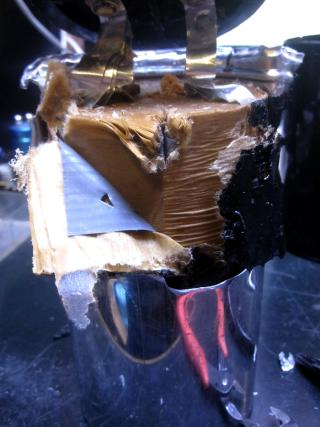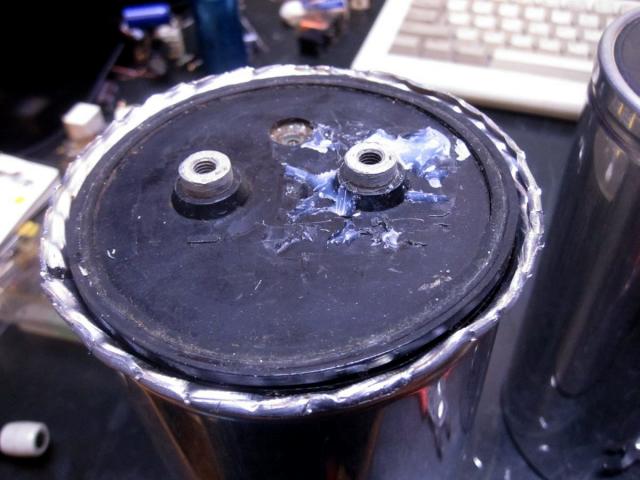

|
| Elliott Sound Products | Fake Hitachi Electrolytic Capacitors |
 Main Index
Main Index Counterfeits Index
Counterfeits IndexThis information was received and published in 2012 (updated in 2018), from info provided by a reader in Mexico City, another in Canada and a further document provided by a reader in the US.
First, from the reader in Mexico ... as always, the details are reproduced (almost) verbatim - a couple of spelling errors have been corrected, but otherwise it's as originally sent to me. The name of the distributor has been partly obscured, but only to ensure that no 'free advertising' is created. A quick search will soon tell you who they are.
Reading on your website on fake transistors, I felt that my discovery of fake large electrolytic capacitors for power amplifier power supplies would interest you.
I live in Mexico City. When trying to upgrade my old MOSFET amplifier (a David Hafler XL-280 from 1989), I bought a pair of very large electrolytic capacitors at a large local distributor called 'AG El...'. Since the beginning, the price seemed a little on the low side, but the large volume of sales at this dealer made me optimistic was possible.
The offending capacitors are labeled as 'HITACHI' but I quickly discovered one of them was dead-on-arrival (open circuit). The other one measured about 95% of the capacitance, which is not typical of large electrolytics; (I have found most good units to be on the high side of tolerance range, usually above +20%).
Further online searching confirmed that the 'FA' series DOES NOT EXIST in the Hitachi line of products. Otherwise, the damn Chinese manufacturer has copied the colour and lettering in golden paint perfectly. Very hard to distinguish from originals by sight. Several people at DIY-Audio.com has seen them in various values, and one of them even was reselling them, but had many failures and stopped handling them. In the end, quality control was almost inexistent and reliability, nil.
As soon as I checked on the web, I found several references on fake Hitachi caps. I returned them, but it was extremely unpleasant having to fight over my money ... the distributor behavior was exactly like the image you show on your website on fake transistors! At last I recovered my money, but had to expend a lot of time and frustration discussing with the 'geniuses' at AG El...'. I am sure those people would have a lot more fake merchandise, so I’ll never buy from them again.
I’m attaching an image of the fake capacitor for your information.
In the near future, I will try to buy from you some Active Crossover parts, but my newly born son is taking so much time from me that High quality Audio will have to wait a little!
I congratulate you for your invaluable information on your site, and keep recommending its reading to all my friends and colleagues.
Best Wishes from Mexico City.

Photo Of A 'Hitachi' 33,000MFD 50V Capacitor
Fake capacitors have been around for a while, and most people will have heard about computer motherboard caps that used a stolen (but incorrect) formula for the electrolyte. Many thousands of motherboards were affected when the caps failed, costing consumers over US$100 million (estimated) to rectify. These caps are probably not in the same league, but as seen above will still cause problems for people who buy them.
Hitachi does (or used to) make a capacitor range called 'HCG F6A', but these are high voltage types (400V and 450V). Hitachi Chemical also issued an ALERT in May 2009 (but no longer available), stating that they were aware of the counterfeit parts and that Hitachi Chemical could not guarantee these capacitors. Not unreasonable, because Hitachi didn't make them. The Hitachi website does not show 'HCGFA' - not when I looked in 2012, and not in 2016. The best guess is that they stopped this series in around 1995 (according to This post on 'badcaps.net'). The caps shown there appear almost identical to those in the next section.
I have also seen the HCG FA series advertised as snap-in types from several on-line sellers. These are completely bogus of course, and anyone who thinks that genuine (high quality, name brand) 22,000µF 63V caps can be sold for less than $7.00 each is probably dreaming. There is a fairly wide price range, but the prices I saw (name brand from major suppliers) were at least three times as much. I didn't see any 33,000uF 'Hitachi' caps, so looked for 22,000µF instead.
Some more pix came to me in November 2016, installed in Chinese light therapy equipment (no details were provided, but it could be similar to the one linked above on the 'badcaps' site). The photos pretty much speak for themselves. As noted above, Hitachi has not made a series called 'HCG FA' since around 1995, which is a dead giveaway. Another good clue is the capacitance marking, claiming '10000MFD' (also used on the cap shown above). Every cap I've seen on the Hitachi website uses µF, and not the 40-odd year old 'standard' of 'MFD' which (as far as I'm aware) was used mainly in the US up until fairly recently, but has not been common elsewhere for many years.
Based on what I can determine from the Hitachi site and capacitor specifications and photos, Hitachi uses the word 'HITACHI' (upper case) on their caps, and does not appear to use their logo. They also specify the surge voltage (e.g. 450V for a 400V capacitor), but unfortunately their date code is inscrutable.


Photos Of 'Hitachi' 10000MFD 450V Capacitors
The photos show a cap from the front, and another split open to reveal its intestines. It looks to be of reasonable construction, but is not a genuine Hitachi product. Capacitance was measured (by my correspondent) at 7,500µF, which is well below what one expects. The Hitachi website claims capacitance is within ±20% (so should not be less than 8,000µF), but in my experience quality caps usually measure very close to (and generally above) their rated value - at least when fairly new. The age of the caps is unknown.
A further document from Hitachi (sent by a reader) shows that the 'HGCFA' series is obsolete, but no date of obsolescence was provided. They were 85°C types. It is possible that the caps involved were old stock, removed from equipment and then sold as new. This could account for the corrosion and the loss of capacitance. Unfortunately, my correspondent did not measure the ESR (equivalent series resistance). This increases well before the capacitance decreases and is a sure sign that a cap is 'old and tired'.

Another Photo Showing The Less-Than-Impressive Top Surface
(In The Process Of Being Dismantled)
There is some corrosion of the terminals, and the third hole (which is a vent according to the Hitachi website) is fairly badly corroded - it looks like rust in one of the other photos (I haven't posted all of them). This is not what one would expect from a premium capacitor.
My correspondent wrote ...
I've been a long time reader of your page and must thank you for your hard work!
I recently opened up a piece of Chinese light-therapy equipment and found some of those wonderful "Hitachi" counterfeit caps. They looked relatively legitimate so I decided to search for specifications online and found much ado about the Chinese fakes. I'm glad I searched as I am no longer comfortable using these in anything. I decided to take one apart and get some photos of the innards.
If you're interested in adding any of this information or the pictures to your existing page on the fake Hitachi FA stuff, please go ahead. If not, I at least hope this useful for general interest. Thanks again and keep up with the great audio work!
- Daniel D from Canada.
It pays to be vigilant, because the counterfeit component business just gets worse as time goes on. There's no end in sight either, and there doesn't seem to be a way to stop it from happening.
 Main Index
Main Index Counterfeits Index
Counterfeits Index